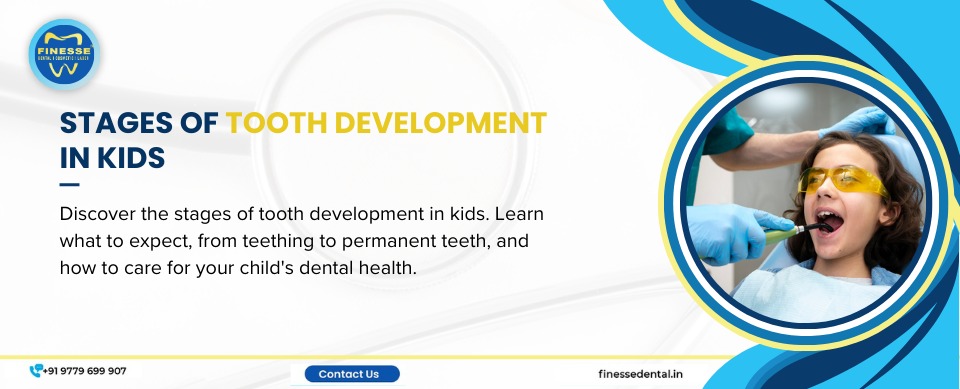- June 3, 2024
- Comment: 0
- Blog
Stages of Tooth Development in Kids
A child’s smile is a source of pure joy, and behind that adorable grin lies a fascinating story of development. From the moment they’re born, a child’s teeth begin a remarkable journey through the gums and into the world. Understanding the stages of tooth development in kids can help parents provide the best care for their little ones’ pearly whites.
The Foundation: Before Baby Teeth Erupt
Even before a baby is born, the groundwork for their future smile is being laid. In the first trimester of pregnancy, the tooth buds, or dental laminae, begin to form within the gums. These tiny buds will eventually develop into both baby (primary) teeth and permanent teeth.
Stage 1: Teething – A Time of Exploration (0-3 years old)
The most anticipated stage is teething, when the first baby teeth break through the gums. This typically begins around 6 months of age, although there can be variations. The lower central incisors (the two front teeth on the bottom) are usually the first to erupt, followed by the upper central incisors.
Teething can be a challenging time for both babies and parents. Symptoms like irritability, drooling, and fussiness are common. To ease discomfort, parents can offer teething toys for gnawing, chilled washcloths to soothe sore gums, or gentle gum massages.
Stage 2: Building a Full Set (1-3 years old)
Over the next 18-24 months, the remaining baby teeth will gradually emerge. Here’s the order you can expect:
- Lateral incisors (next to the central incisors) – top and bottom
- Canines (pointed teeth) – top and bottom
- First molars (the teeth further back in the mouth) – top and bottom
- Second molars – top and bottom
Stage 3: A Period of Calm (3-6 years old)
Once all 20 baby teeth have erupted, there’s a period of relative calm before the permanent teeth start to arrive. This is a crucial time to focus on good oral hygiene habits like brushing twice a day and flossing to prevent cavities in the baby teeth.
Stage 4: The Permanent Teeth Arrive (6-12 years old)
Around 6 years old, the exciting process of permanent tooth eruption begins. The first permanent teeth to arrive are usually the molars behind the baby molars. These are followed by the central incisors at the front, replacing the baby teeth.
The permanent teeth continue to erupt over the next few years, with the canines emerging around 9-13 years old and the second molars arriving around 11-13 years old. Wisdom teeth, the third molars, may or may not erupt and can sometimes require extraction.
Stage 5: A Complete Smile (12 years old and beyond)
By the time a child reaches their late teens, they should have a complete set of 32 permanent teeth (unless wisdom teeth are removed).
Caring for Your Child’s Smile Throughout the Stages
Here are some key things to remember throughout the stages of tooth development in kids:
- Regular Dental Checkups: Schedule your child’s first dental visit by their first birthday or when their first tooth erupts. Regular checkups allow dentists to monitor development, identify potential issues early, and provide guidance on proper dental hygiene.
- Brushing and Flossing: Even with baby teeth, good oral hygiene is essential. Start brushing your child’s teeth twice a day with a soft-bristled brush and fluoride toothpaste as soon as they erupt. Flossing can begin once teeth start to touch.
- Healthy Diet: A balanced diet rich in calcium and vitamins is crucial for healthy tooth development.
- Pacifier and Thumb Sucking: While sucking can be a comforting habit for babies, prolonged pacifier or thumb sucking can lead to misalignment of teeth. Encourage your child to break the habit by age 4.
- Dental Emergencies: If your child experiences a chipped tooth, a loose tooth that seems abnormal, or any other dental concern, contact your dentist promptly.
Understanding the stages of tooth development in kids empowers parents to provide the best care for their children’s oral health. By taking proactive steps and working with a dentist, you can help your child develop strong, healthy teeth that will last a lifetime. Remember, a healthy smile not only promotes good oral health but also boosts confidence and well-being in children. Let’s work together to ensure their smiles stay bright and beautiful throughout their lives!

